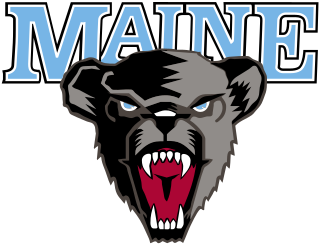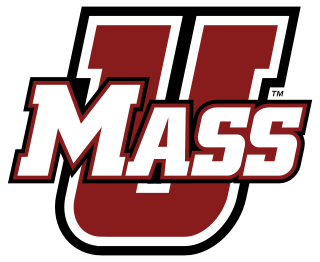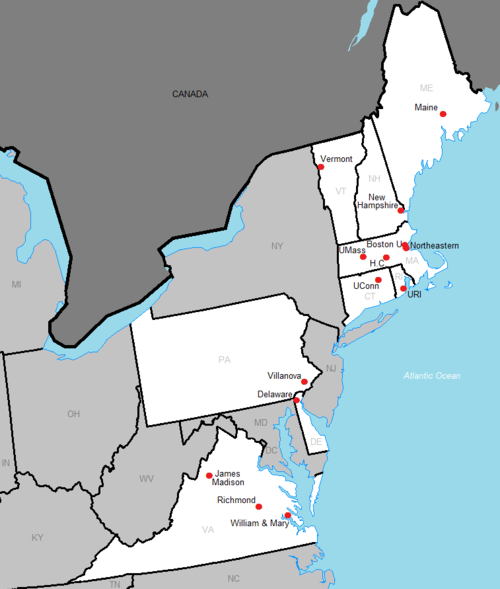
National Collegiate Athletic Association (NCAA) Football Bowl Subdivision independent schools are four-year institutions whose football programs are not part of an NCAA-affiliated conference. This means that FBS independents are not required to schedule each other for competition like conference schools do.

The Atlantic 10 Conference (A-10) is a collegiate athletic conference whose schools compete in the National Collegiate Athletic Association's (NCAA) Division I. The A-10's member schools are located mostly on the East Coast and Midwest of the United States: Illinois, Massachusetts, Missouri, New York, North Carolina, Ohio, Pennsylvania, Rhode Island, Virginia, and Washington, D.C.

The America East Conference (AmEast) is a collegiate athletic conference affiliated with NCAA Division I whose members are located in the Northeastern United States. The conference is headquartered in Boston, Massachusetts.

NCAA Division I (D-I) is the highest level of intercollegiate athletics sanctioned by the National Collegiate Athletic Association (NCAA) in the United States, which accepts players globally. D-I schools include the major collegiate athletic powers, with large budgets, more elaborate and nicer facilities and a few more athletic scholarships than Divisions II and III as well as many smaller schools committed to the highest level of intercollegiate competition.
Three popular American sports were invented in New England. Basketball was invented by James Naismith, a Canadian, in Springfield, Massachusetts, in 1891. Volleyball was invented by William G. Morgan in Holyoke, Massachusetts, in 1895. Paintball was invented in 1981 in Henniker, New Hampshire.

The Maine Black Bears are the athletic teams that represent the University of Maine. A member of the America East Conference, the University of Maine sponsors teams in eight men's and nine women's NCAA sanctioned sports. The men's and women's ice hockey teams are members of Hockey East, and the football team is an associate member of the Coastal Athletic Association.

The Providence Friars are the intercollegiate athletic teams that represent Providence College, located in Providence, Rhode Island. They compete in the Big East Conference for every sport except for ice hockey, where they compete in Hockey East. The Big East Conference was founded in 1979 by former athletic director and men's basketball coach Dave Gavitt. On December 15, 2012, Providence and the other seven Catholic, non-FBS schools announced that they were departing the Big East for a new conference; on March 7, 2013, it was officially confirmed that Providence's new conference would operate under the Big East name. The women's volleyball team, which had been an associate member of the America East Conference before the Big East split, remained in that conference for one more season before joining the Big East for the 2014 season.

The UMass Minutemen are the athletic teams that represent the University of Massachusetts Amherst; strictly speaking, the Minutemen nickname applies to men's teams and athletes only — women's teams and athletes are known as Minutewomen. The Minutemen and Minutewomen compete in NCAA Division I sports competition primarily as members of the Atlantic 10 Conference. UMass is one of only 16 universities in the nation that plays Division I FBS football and Division I men's ice hockey. The nickname is also applied to club teams that do not participate within the NCAA structure.

The UMass Minutemen football team represents the University of Massachusetts in the NCAA Division I Football Bowl Subdivision (FBS). The Minutemen compete as an FBS independent. Since 1965, their home games have been played at Warren McGuirk Alumni Stadium on the university's campus in Hadley, Massachusetts.

The Rhode Island Rams football program is the intercollegiate American football team for the University of Rhode Island located in the U.S. state of Rhode Island. The team competes in the NCAA Division I Football Championship Subdivision (FCS) and are members of the Coastal Athletic Association Football Conference. Rhode Island's first football team was fielded in 1895. The team plays its home games at the 6,555 seat Meade Stadium in Kingston, Rhode Island.

The Rhode Island Rams baseball team is the varsity intercollegiate baseball team of the University of Rhode Island, located in Kingston, Rhode Island, United States. The program has been a member of the NCAA Division I Atlantic 10 Conference since the start of the 1981 season. Since the 1966 season, the program has played at Bill Beck Field, located on the university's campus. The program has appeared in two NCAA tournaments. It has won two conference tournaments, three regular season conference titles, and three regular season division titles. Three former Rams have appeared in Major League Baseball.

The Eastern Collegiate Women's Hockey League (ECWHL) is an American Collegiate Hockey Association Women's Division 1 club level hockey-only college athletic conference for women's hockey teams. It is one of four ACHA Women's Division 1 conferences, along with the Central Collegiate Women's Hockey Association, the Western Women's Collegiate Hockey League, and Women's Midwest College Hockey. Primarily, the league has been concentrated in New England and Upstate and Western New York, with eleven of its thirteen members over fourteen seasons based in those areas.

The New England Conference was a collegiate sports conference in the Eastern United States, more specifically in New England, that operated from 1923 to 1947. As four of its charter members remained aligned in football from the conference's inception through 2011, this conference can be considered the earliest ancestor of today's Colonial Athletic Association football conference.

The Vermont Catamounts football program was the intercollegiate American football team for the University of Vermont located in Burlington, Vermont. The team competed in the NCAA Division I and were members of the Yankee Conference. The school's first football team was fielded in 1886. The football program was discontinued at the conclusion of the 1974 season.

The 2010–2013 Colonial Athletic Association realignment refers to the Colonial Athletic Association (CAA), renamed in 2023 to the Coastal Athletic Association, and Colonial Athletic Association Football Conference dealing with several proposed and actual conference expansion and reduction plans among various NCAA conferences and institutions from 2010 to 2013. Some moves affected only the all-sports CAA; others affected only CAA Football; and still others affected both sides of the CAA. Moves that involved the overall CAA were part of a much larger NCAA conference realignment.
The 1974 Boston University Terriers football team represented Boston University as a member of the Yankee Conference during the 1974 NCAA Division II football season. In its second season under head coach Paul Kemp, the team compiled a 5–4–1 record, placed in a four-way tie for third in the Yankee Conference, and outscored opponents by a total of 145 to 129.

The Coastal Athletic Association Football Conference, formerly the Colonial Athletic Association Football Conference, branded as CAA Football, is a collegiate athletic conference affiliated with the NCAA's Division I whose full members are located in East Coast states, from Maine to North Carolina. Most of its members are public universities, and the conference is headquartered in Richmond, Virginia. The conference is run by the same administration as the multisport conference Coastal Athletic Association but is legally a different entity.














